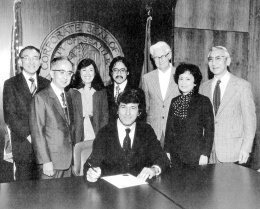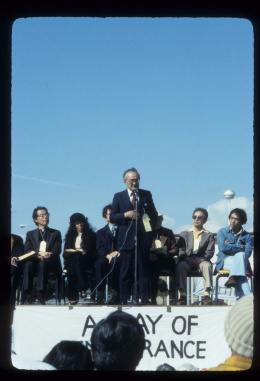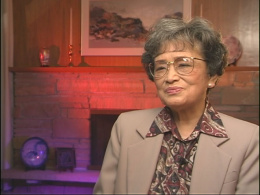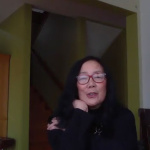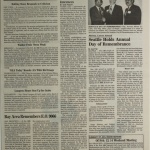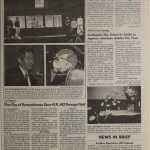Days of Remembrance
Days of Remembrance are annual events held in cities across the country around February 19 to observe the signing of Executive Order 9066 , which authorized the incarceration of people of Japanese ancestry into United States concentration camps during World War II. [1]
First Day of Remembrance
The first Day of Remembrance was held in Seattle on November 25, 1978, over the Thanksgiving weekend. Volunteers re-enacted the removal of the Seattle Japanese American community to the Puyallup Assembly Center. The idea to stage a Day of Remembrance was in response to the stalled redress movement at the time.
Award-winning playwright Frank Chin came up with the idea in hopes of revitalizing the movement. Mayumi Tsutakawa, daughter of famed sculpturist George Tsutakawa, is credited with coming up with the expression, "Day of Remembrance," for the program. Since the group had to pull the event together in a few weeks, the volunteer organizers put in 10 to 14 hour days, and Frank Abe even quit his job to devote his full time to the program. Frank Fujii created the "ichi-ni-san" barbed wire symbol that became the DOR's logo.
Posters resembled the original wartime "Instructions To All Persons of Japanese Ancestry" posters and were nailed to telephone poles just as they had been done during the war. Organizers also produced replicas of family name tags to give to attendees. On the day of the event, Seattle participants were to gather at a vacant lot next to the old Seattle Pilots baseball park and caravan to Puyallup, while those from other cities such as Tacoma were to head directly to Puyallup. Organizers were stunned to get more than 2,200 people come out to register at the vacant lot. The caravan to Puyallup stretched for over four miles down Interstate 5. Another estimated 1,000 people showed up directly at Puyallup. The event was picked up by the mainstream and ethnic media nationwide.
The second DOR was held in Portland, after Portland Japanese American Citizens League President Jim Tsujimura enlisted Chin's help in organizing something similar in Portland. The date was moved to around February 19 to observe the anniversary date of the signing of E.O. 9066.
Subsequent Events
As more cities began organizing DORs, the program began attracting a broader audience, beyond just the Japanese American community, and receiving coverage by more mainstream media outlets. Organizers also began inviting elected officials, who supported the redress bill, to speak at their DOR programs. The DORs had another effect. It gave former camp inmates another outlet in which to share their experiences with family members and the general public.
Until the redress bill passed in 1988, the DOR programs mainly focused on pushing for an apology from the government and monetary compensation for what had occurred during the war. Once redress for Japanese Americans was won in 1988, DOR programs started to focus on the plight of Japanese Latin Americans (JLA), Japanese Canadians and broader issues connected to civil rights violations. Congressman Xavier Becerra has spoken at a number of Los Angeles DORs to update audience members on the status of the JLA redress bill. Some DOR organizers also use the program to recognize individuals or organizations that have fought for civil rights.
After the Sept. 11, 2001 Al-Qaeda attack on the Twin Towers and the Pentagon, DOR programs started revolving around issues linked to people of Middle Eastern descent who were confronting similar problems of racial profiling, hate crimes and unjust detention that Japanese Americans had experienced shortly after Japan attacked Pearl Harbor .
Currently, more than 20 cities across the nation hold annual DORs, including in the nation's capital. However, as more camp inmates pass away, DOR organizers face the challenge of attracting a younger audience, many of whom may not be aware that they were able to grow up in a more tolerant society due to the efforts of their predecessors.
For More Information
Iwamura, Jane Naomi. "Critical Faith: Japanese Americans and the Birth of a New Civil Religion." American Quarterly 59.3 (September 2007): 937–68.
McFadden, Christine. "What Day of Remembrance Means to Today's JA Youth." Pacific Citizen , February 17, 2012.
Murray, Alice Yang. Historical Memories of the Japanese American Internment and the Struggle for Redress . Stanford: Stanford University Press, 2008.
[ http://www.ncrr-la.org/DORarchive/index.htm "NCRR Day of Remembrance Archives."]
Shimabukuro, Robert Sadamu. Born in Seattle: The Campaign for Japanese American Redress . Seattle: University of Washington Press, 2001.
Takezawa, Yasuko I. Breaking the Silence: Redress and Japanese American Ethnicity . Ithaca: Cornell University Press, 1995.
Footnotes
- ↑ Sources for this article include interviews with Frank Abe, Frank Chin, and Henry Miyatake.
Last updated Dec. 19, 2023, 5:40 p.m..

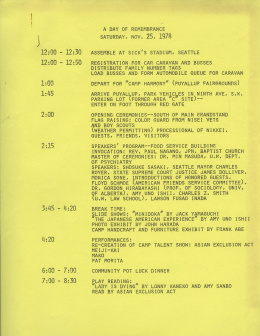 Media
Media
